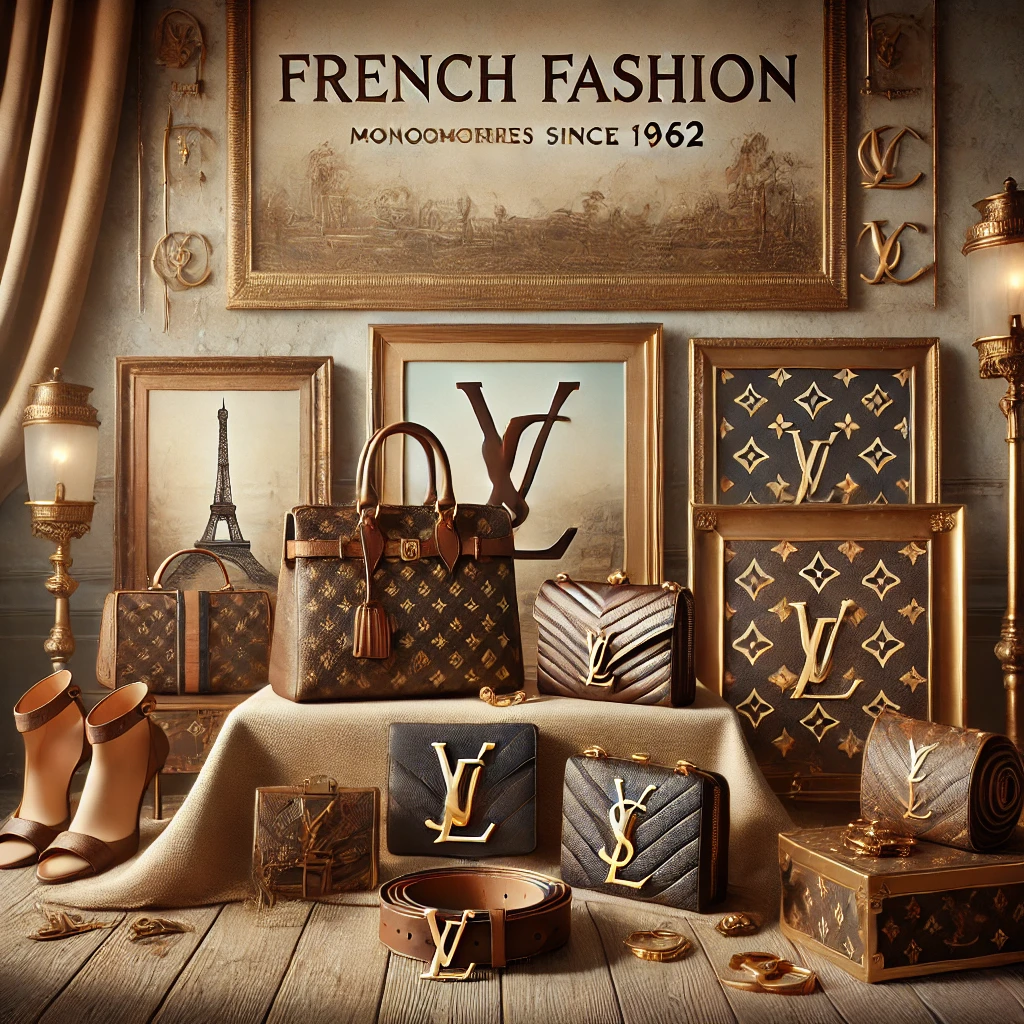Table of Contents
Introduction
French fashion has always been synonymous with luxury, elegance, and timeless style. From the opulent runways of Paris to the chic streets of Lyon, French designers have led the charge in revolutionizing global fashion trends. One of the most iconic elements of French luxury fashion is the use of the monogram. French Fashion Monogram Since 1962 , houses have been perfecting and expanding the art of monogramming, turning logos and initials into coveted symbols of status and style.
Monograms have become more than just branding—they represent a unique blend of tradition, identity, and craftsmanship. Whether it’s emblazoned on a designer handbag or delicately embroidered onto a silk scarf, the monogram has been a powerful statement in French fashion for decades.
The Evolution of French Fashion Monogram Since 1962
A fashion monogram refers to the use of initials or symbols that represent a brand. This technique dates back centuries but found its true moment of fame in French luxury fashion after 1962 ( French Fashion Monogram Since 1962) . Monogramming became a symbol of personal identification, signifying a link between the product and its owner’s status or identity.
The 1960s marked the rise of fashion houses embracing monograms, particularly in leather goods and accessories. The simplicity and elegance of these symbols reflected French minimalism while exuding luxury and prestige.
The Role of Luxury Brands in Shaping Monogram Culture
When we talk about monograms in fashion, a few iconic French brands come to mind—Louis Vuitton, Yves Saint Laurent (YSL), and Chanel. These fashion houses not only popularized the monogram but transformed it into a global phenomenon.
Each brand’s unique approach to monogramming helped define its identity and appeal. For example, Louis Vuitton’s famous “LV” pattern became a worldwide sensation, while Yves Saint Laurent combined art and fashion with its sleek, intertwined initials.
To explore more about French fashion icons, visit Glamour Script for deeper insights into luxury and style.
Louis Vuitton: The Iconic Monogram
The Louis Vuitton monogram, first introduced in the late 19th century, saw a resurgence in popularity in the 1960s and continues to be one of the most recognizable logos in the world. The “LV” symbol is synonymous with luxury, heritage, and craftsmanship. By the 1960s, the brand began incorporating its monogram into new product lines, further solidifying its place in the fashion world.
Louis Vuitton’s monogram is not just a logo—it’s a story of tradition and innovation. Every bag, belt, and scarf that bears the monogram tells a tale of French artistry that transcends time.
Yves Saint Laurent: Revolutionary Monogram Style
Yves Saint Laurent (YSL) was one of the first designers to blend high fashion with monograms in a way that felt artistic yet accessible. In the 1960s, YSL embraced the monogram, using it in designs that challenged the boundaries between art and clothing. The brand’s bold, minimalist monogram reflected the chic sensibility of Parisian fashion.
Today, YSL monograms are found on everything from sunglasses to handbags, embodying the house’s legacy of elegance and modernity.
The Cultural Impact of Monograms in French Fashion
Monograms have always signified exclusivity. Wearing a monogrammed piece means you are carrying more than just a product—you’re embracing a heritage, a brand, and a statement of wealth. French fashion houses understood the power of monograms to evoke a sense of belonging and status, making them integral to their branding.
The Monogram Renaissance: 1980s and 1990s
In the 1980s and 1990s, monograms made a bold comeback, especially in streetwear fashion. High-end brands like Louis Vuitton and Chanel began incorporating monograms into edgier, more accessible designs, making them popular across all demographics.
The rebirth of the monogram in these decades brought an influx of collaborations between fashion houses and contemporary artists, further pushing monogram culture into mainstream consciousness.
Monogramming in Accessories
Monograms in French fashion aren’t just for clothing. They extend to accessories like bags, belts, scarves, and even shoes. Louis Vuitton’s and YSL’s famous monogrammed bags have become staple items in the world of luxury fashion, with new designs being released each season.
Sustainability in Monogram Fashion
French fashion houses are now considering the environmental impact of monogrammed products. As sustainability becomes more crucial in the fashion industry, designers are adapting by using eco-friendly materials and innovative production techniques to reduce waste while maintaining luxury standards.
Brands are exploring organic cotton, recycled materials, and energy-efficient production processes, setting new standards for the future of fashion.
The Future of French Fashion Monogram Since 1962
The future of French monograms looks brighter than ever, with innovations in digital design and even 3D printing. Brands are experimenting with personalized monogramming, allowing customers to customize items to their tastes while retaining the luxurious feel of traditional monograms.
Monogramming Beyond France
The influence of French fashion extends far beyond its borders, especially when it comes to monogramming. From American to Asian luxury markets, French fashion houses have set the gold standard. Brands like Louis Vuitton and YSL have inspired countless designers globally to adopt monogramming techniques in their collections.

American designers like Ralph Lauren and Coach have incorporated monogramming, drawing from the elegance and heritage seen in French designs. Similarly, luxury brands in Asia, particularly in Japan and South Korea, have embraced French-inspired monograms, blending them with their unique cultural aesthetics.
This international reach solidifies the timeless appeal of French monogram fashion ( French Fashion Monogram Since 1962).
Monogramming Techniques: Craftsmanship and Innovation
Creating a monogram isn’t just about slapping initials onto a product—it’s an intricate process that blends artistry and innovation. French fashion houses employ highly skilled artisans to ensure each monogram piece is crafted to perfection. Techniques include embroidery, printing, embossing, and even digital design in today’s age of fashion tech.
For brands like Louis Vuitton, the monogram is hand-applied onto leather using a meticulous printing process, ensuring the quality and longevity of the design. This dedication to craftsmanship makes French monogrammed items not just accessories, but works of art.
Modern-Day Monogram Trends
Monograms have made a roaring comeback in recent years, particularly with Gen Z and millennials. Personalization has become a significant trend, and monogramming plays a crucial role in this. From initials on bags to bespoke monogrammed clothing, today’s fashion-conscious consumers are looking for ways to make a statement while staying on-trend.
Social media platforms like Instagram and TikTok have also played a role in the monogram resurgence. Influencers and celebrities are often seen flaunting their monogrammed luxury items, further fueling the trend among younger generations.

The Future of French Fashion Monograms
The future of monograms is looking bright and innovative. With advancements in digital fashion and 3D printing, French designers are exploring new ways to elevate monogramming. We may soon see entirely digital fashion collections, where monograms are integrated into virtual clothing. This intersection of technology and fashion is set to revolutionize how we perceive and wear monograms.
Moreover, as sustainability becomes more critical, French fashion houses are exploring eco-friendly materials and methods for creating their iconic monograms. Expect to see brands push the boundaries of fashion tech while maintaining the luxurious feel and prestige associated with French monograms.
Conclusion
French fashion monogram since 1962 have withstood the test of time, evolving from simple branding techniques into cultural symbols of luxury, identity, and artistry. From Louis Vuitton’s timeless “LV” to YSL’s innovative monogram designs, these brands have continuously adapted to the changing times, while maintaining the exclusivity and craftsmanship that make them iconic.
Whether you’re a lover of high fashion or just beginning to explore the world of luxury, French monograms offer a unique blend of history, innovation, and style. And as fashion continues to evolve, one thing is for certain—the allure of the French monogram isn’t going anywhere.
For more articles on luxury fashion, visit Glamour Script and discover the latest in high-end trends and style.
FAQs
1. How did French monogram fashion start?
French monogram fashion began to gain prominence in the 1960s with brands like Louis Vuitton leading the way, creating monograms that represented luxury and craftsmanship.
2. What makes French monograms different from others?
French monograms are distinguished by their heritage, craftsmanship, and association with luxury. French fashion houses like Louis Vuitton and YSL have set the standard for monogramming in the fashion industry.
3. Are monograms still popular in modern fashion?
Yes! Monograms have made a significant comeback, especially among younger generations. Personalized and bespoke monograms are a major trend in today’s fashion world.
4. How are French fashion brands making monograms sustainable?
Many French fashion brands are focusing on sustainability by using eco-friendly materials and production methods in their monogrammed products, ensuring luxury with a reduced environmental impact.
5. What is the future of monogramming in French fashion?
The future of monogramming lies in digital and 3D-printed designs, as well as continued innovation in sustainability. Monograms will remain a key element in the luxury fashion industry.













































